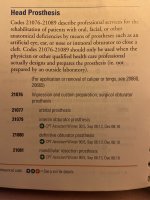E0485 is for a pre-fabricated device, whereas E0486 is for a custom-device. Is your Somnoguard device custom-fabricated from impressions of the patients dentition?
I have a related question. Can a provider use 21085 for impressions/fabrication of an obstructive sleep apnea device, if 1) the provider takes the impressions in office and 2) sends the materials to an independent lab for fabrication, for a patient who 3) does not require any open-cutting or surgical procedures?
Based on my CPT book, it seems an anatomical deficiency needs to exist. Barring a co-existing cleft or something of that nature, I don’t know if an argument could be made that patients with obstructive sleep apnea all have anatomical deficiencies. However, it seems crystal-clear (to me) that the criteria regarding an outside lab means the provider should not use this code. Any thoughts?
What about 21110 for retainers? These are not permanently affixed to the teeth/jaw. They are used daily and inserted/removed by the patient.
Was 21085 or 21110 ever appropriate for sleep apnea DME? Did the advent of E0485/86 make these codes obsolete for this service?
